YOU ARE HERE >> AmazingRibs » Ratings & Reviews » Ratings Reviews And Buying Guides » AmazingRibs.com Gift Guide for BBQ and Grilling » BBQ Gifts $500+ » Weber Genesis II E-335 Gas Grill Review
Weber Genesis II E-335 Gas Grill Review
All of our reviews are done independently by our team of testers and are in no way influenced by advertising or other monetary compensation from manufacturers. Click here to learn more about our unbiased product review process.
Published On: 3/18/2019 Last Modified: 11/8/2025
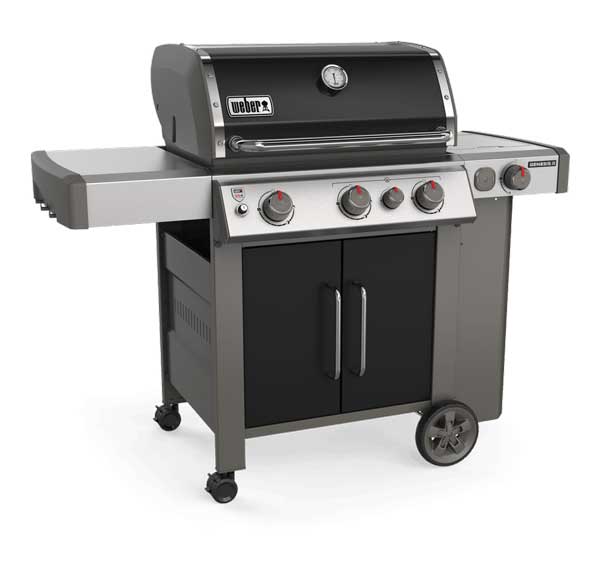
The 2019 Weber Genesis II E-335 three burner with sear burner, side burner and an enclosed cart is one nice gas grill! This is the latest iteration of Weber’s popular Genesis grill. In 2017, Weber rolled out two revised versions of Genesis, changing the names to Genesis II and Genesis II LX. We were among the many disappointed, particularly in the higher priced LX models. The whole situation seemed like a rare stumble for one of our favorite brands. Weber fans may now breathe a sigh of relief as Genesis returns in fine form with a second try. We’re calling it Genesis II 2.0.
Thankfully, Weber reinstated models with sear burners. One of the questionable decisions made with the previous Genesis II was the complete elimination of sear burners. Many gas grills cannot effectively produce intense searing temps and need additional sear burners to get that truly mouth watering steakhouse sizzle. Though we found the 13,000 BTU stainless steel main burners on our E-335 had an exceptional temperature range, the additional 9,000 BTU sear burner goosed temps over 800°F and left no doubt about the searing performance.
A member of our Pitmaster Club had a good question, “How do I know I’m getting the revised Genesis II?” An obvious sign is sear burners. The previous Genesis II line didn’t have any models with a sear burner. Model numbers 315, 335 and 435 are new for 2019. Lastly, per Weber, serial numbers on the 2019 models start with AE or GU.

GS4 Grilling System
Genesis II features Weber’s GS4 grilling system. GS4 consists of Infinity Ignition, tapered-quadrangle shaped burners, and a redesigned grease removal system.
Weber claims Infinity Ignition is more robust and consistent than their older ignition systems, and they back it up with a ten year warranty. It has a single, battery powered ignitor with no crossover.
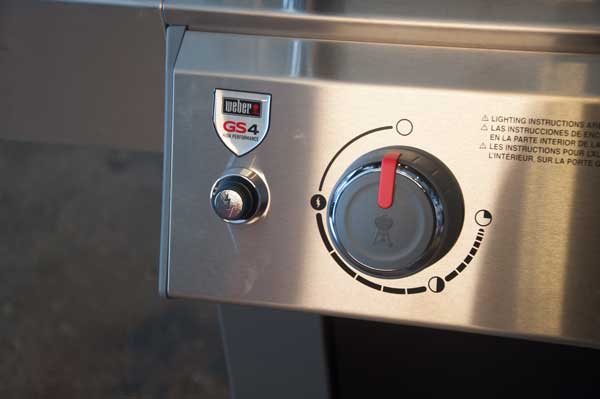
Crossover enables one lit burner to ignite other burners. Without crossover, the ignitor must be pressed to fire up each, individual burner. A small inconvenience, but Infinity performed flawlessly throughout our tests. The GS4 burners are meant to improve heat distribution. Note the unusual rectangular shape below.
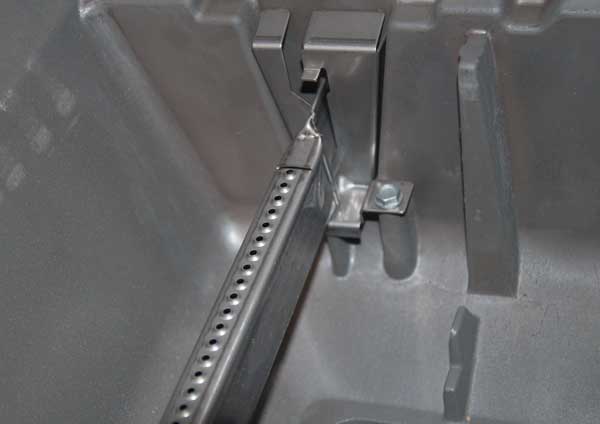
Our E-335 sear burner is shown below, located between the middle and right burner in the cast aluminum firebox. The rust-proof aluminum housing has great thermal conductivity for holding and distributing heat.
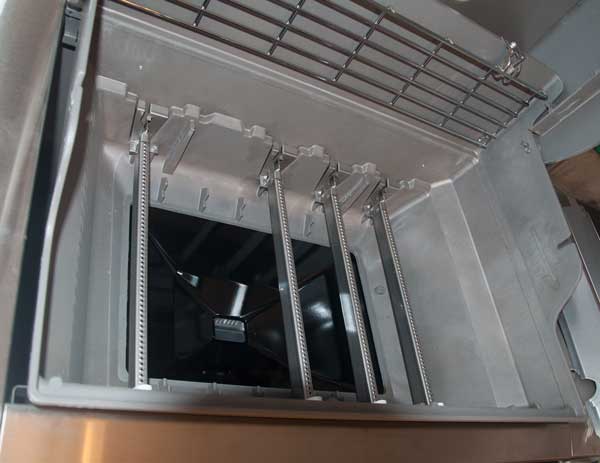
Features
Under the center of the cast aluminum fire box is the grease management system: a black, slide out tray that funnels gunk into a disposable aluminum pan for easy clean up.
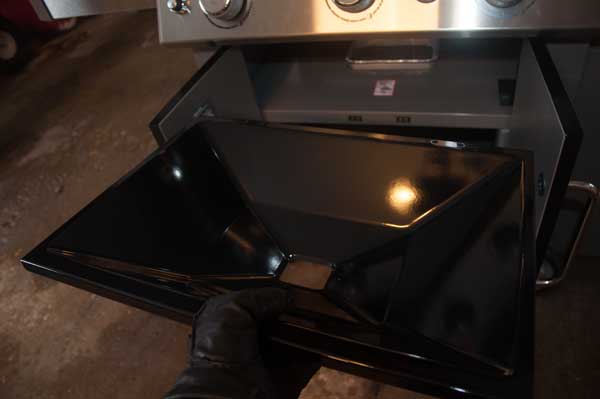
The disposable pan is set into a shelf in the cart. The system is the same on open cart models that have no doors.
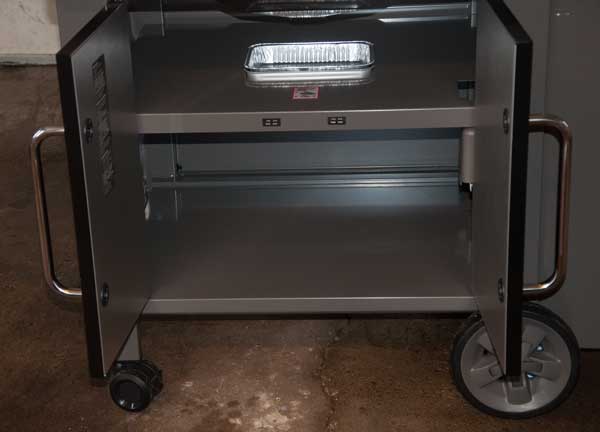
All Genesis II 2.0 models are now equipped with long-lasting, stainless steel flavorizer bars that sizzle drippings and shield burners. In the past, less durable porcelain enameled bars were standard and stainless steel bars were reserved for higher priced models. That’s a nice upgrade for GII 2.0! Note the notches on the sides of each bar which provide a visual confirmation that the burners beneath are indeed lit.
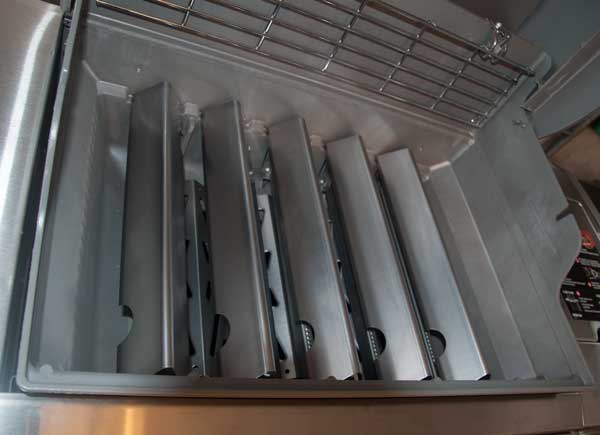
You gotta love the warming rack.
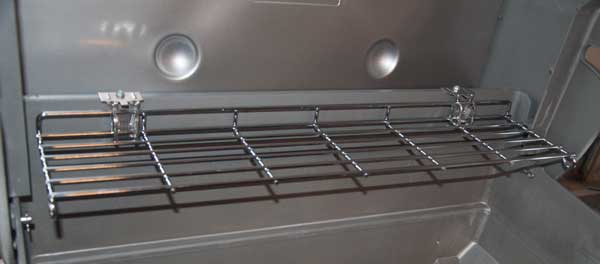
It quickly drops down and out of the way for rotisserie use or when you want clear access to the entire cook surface.
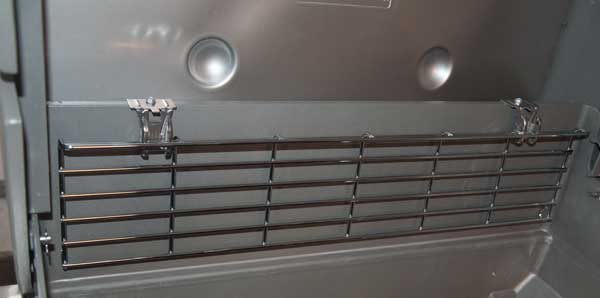
Cooking Grates
Most Genesis II models come with two sided, coated cast iron cooking grates with a flat side (below left) which creates thick sear marks and a thin side (below right) which Weber believes is “ideal for food such as shrimp and fish.”
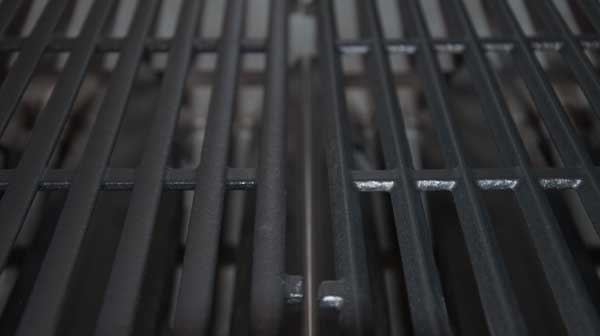
We’re not fans of cast iron grates because they overpower foods with intense conductive heat at the point of contact, creating those alternating bands of dark brown and pale tan known as sear marks. If it’s flavor you want (which you do), the ultimate goal is an even sear across the entire surface of the meat, which transforms dull, tan meat to a delicious flavorful crust thanks to the magical Maillard reaction. More Maillard = more flavor.
Gas grill manufacturers often rely on cast iron conduction to amplify heat from low powered burners and at least add some brown sear marks to food surfaces. Click here for more info on conduction, convection and radiant cooking. We clocked temps on our Genesis II at 680°F with all three main burners on high, and 820°F with the sear burner cranked. That’s steakhouse sear power that doesn’t need cast iron. Some of the premium priced GII models come with stainless steel rod grates, which we prefer. The stainless steel rods allow the radiant gas flames to develop a tasty brown crust over the entire meat surface. Click here to learn about grill grate designs.
Cooking temperature was fairly even with the back and center running slightly hotter as shown in our bread test below.
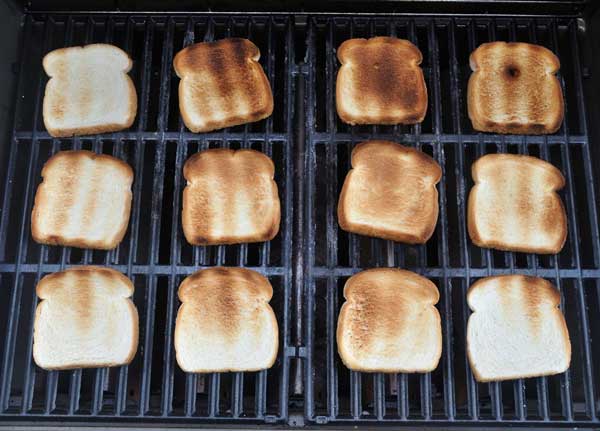
Let the Grilling Begin
A whole chicken was first on our test menu. You want to cook whole birds evenly at moderate temperatures to slowly crisp the skin. With all burners on low, the temp range of around 400°F was a bit too hot for slow roasting a chicken, so we changed course and went for a 2-zone setup, following Weber’s instructions to turn off the middle burner and leave the left and right burners on Low. Then we placed the chicken in the middle in the indirect heat zone. Click here to learn more about the essential technique of 2-zone cooking.
To monitor the cooking temperature, we never rely on thermometers built into the grill hood as they are notoriously inaccurate. Instead, we placed our digital thermometer in the middle area where it registered a cooking temp of 295°F. The sweet spot for roasting chicken is 325°F. At that temperature, poultry cooks gently and thoroughly while developing delicious brown skin. Cook too low and you risk dry meat and rubbery skin; too high and you may have to snatch the bird off the grill to prevent burning the outside before it is properly cooked inside. We dialed up to 325°F by goosing the left and right burners almost to “Medium” on the control knobs and were rewarded with a crisp and juicy bird.
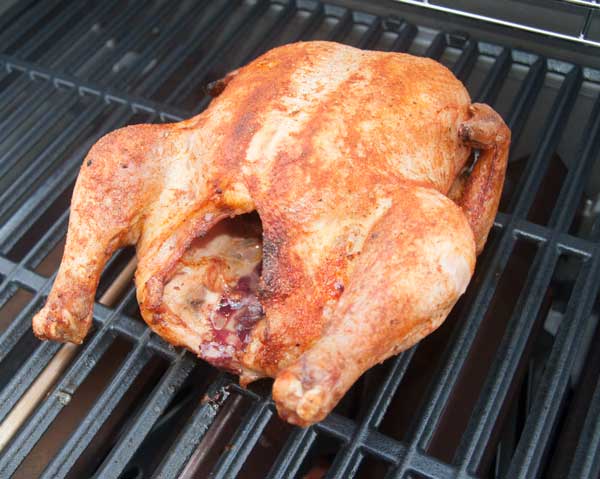
Setting up 2-zone cooking on Genesis II was remarkably easy and didn’t require use of a water pan to moderate the temp as some gassers do. What’s the difference between a water pan and drip pan? Good question. Click here to find out.
Sear Time!
The next test was a couple one and a half inch thick strip steaks. While Genesis II 2.0 main burners get mighty hot, models with additional sear burners like our E-335 blast past 800°F into steak house temps. You can sear foods like thin steaks, shrimp and veggies hot and fast. But if you want a thick steak with delicious, brown crust on the outside and a pink, juicy center, reverse sear is the way to go. With reverse sear, aka sear in the rear, you can make better than steakhouse steaks at home. The process is simple. Start cooking thick steaks low and slow at 225°F until the internal meat temp gradually reaches about 110°F, then crank the heat to the max and quickly sear the exterior.
Once again, we used a 2-zone setup. By leaving the middle and right burners off, we were able to dial up 225°F on our right, indirect side with the left burner set between “Medium” and “High.” Time for a glass of wine while our steaks slowly reached the target temp. At 110°F internal meat temp we removed the strip steaks and cranked all four burners. After five minutes we returned the steaks to our blazing hot grill, flipping early and often while checking meat temp with our digital, instant read thermometer. When they hit about 130°F, we whisked them indoors to the cutting board. The result was a sizzled delicacy with bumper to bumper pink goodness inside. Click here for the recipe.
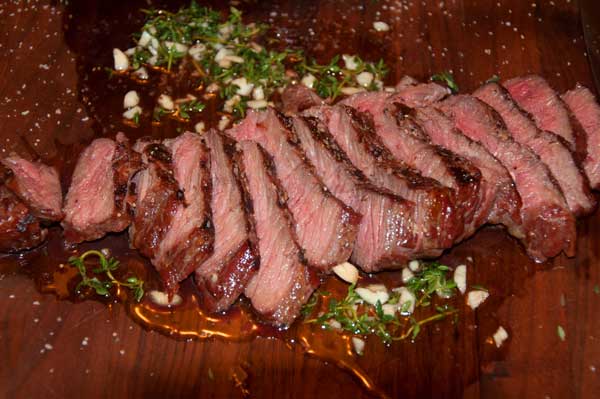
The steak above was prepared with a board sauce of olive oil with fresh garlic and thyme. Board sauces are an easy way to add flair and flavor. Click here to learn more.
iGrill3 Digital Thermometer
Our main complaint for just about every grill is the obligatory, built-in heat estimator in the hood. These 19th century gauges placed up high in the lid can be off by 50 to 100 degrees from the actual cooking temp. Since we cook down on the grates, it’s always better to use a modern, digital thermometer and position a temperature probe at the cooking surface. Click here to learn about the importance of digital thermometers.
With their acquisition of iGrill Digital Thermometers, Weber is addressing this issue. Genesis II is “iGrill3 Ready” with a mounting place on the right side shelf for an optional iGrill 3 digital thermometer. It comes with two temperature probes and has inputs for two more. Download Weber’s free, user friendly app to monitor cooking and internal meat temperatures, and set timers and alarms.
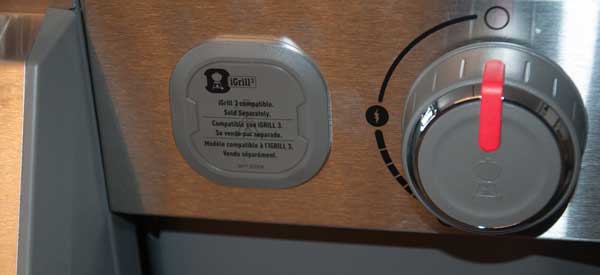
This Bluetooth device enables you to clip a digital probe on the grate to dial up the correct cooking temp, and poke another one in your food to monitor internal meat temp. We tested the iGrill3 readings with our Gold Medal Award Winning Fireboard Digital Thermometer and they were spot on. The convenience of an accurate, built-in digital thermometer is well worth the additional expense. This is especially true if you don’t already have a digital thermometer. Check out iGrill3 on Amazon. Here’s a brief video from Weber about iGrill3 installation and use.
Packaging and Assembly
Packaging was excellent with all parts secured to prevent shipping damage. Weber’s thoughtful design and quality construction were evident throughout assembly. We noted how parts were grouped and packed together in a logical way that mirrored the step by step instructions.
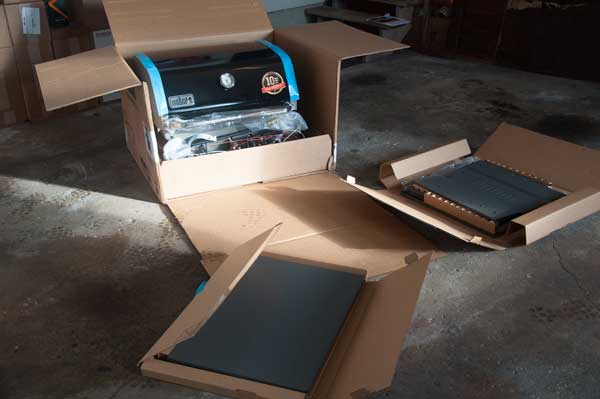
Conclusion
Genesis is back. It’s easy to use, easy to clean, versatile, durable and backed by Weber’s excellent customer support. The basic models with an open cart and no sear burner work fine, but we highly recommend spending the extra money for models with a sear burner, and if you don’t already own a digital thermometer, the iGrill3 is a must have item. Keep in mind that Weber products are built to last. So, you’ll get many years of enjoyment from those useful extras.
The 2019 Genesis II lineup is available in three and four burner configurations, for liquid propane or natural gas, with or without side burners and sear burners, and your choice of an open or enclosed cart. Below is the Genesis II E-425 4-Burner Natural Gas version.
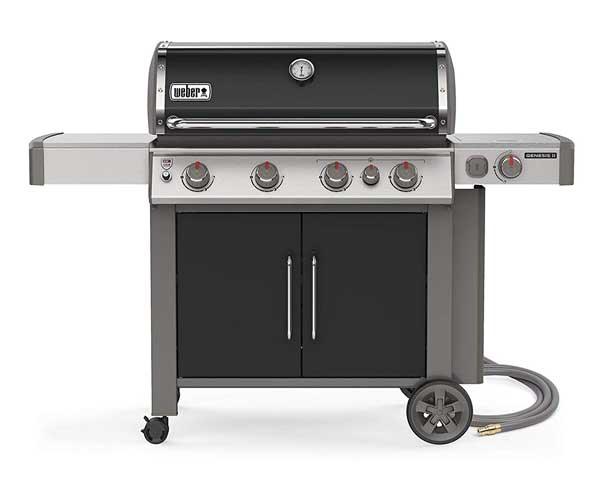
The left and right side shelves have integrated tool hooks and LP models have Weber’s Fuel Gauge, which estimates gas tank level by weight. All models are available in black. Certain models are offered with stainless steel hoods and color choices of copper, crimson or smoke.
Genesis II has a bumper to bumper 10 year limited warranty on all parts.
We thank Weber for providing a Genesis II E-335 for our tests.
Click the buttons below to search our complete database of reviews:
Product Information:
-
Model:Genesis II E-335 Gas Grill
-
Item Price :1,129.00
*Price Subject To Change -
Where to buy (buying from this supplier supports this website):
-
Review Method:Cooked On It
We have hands-on experience testing this product. We have also gathered info from the manufacturer, owners and other reliable sources. -
Primary Function:Grill
-
Burner Type:Side, Sear
-
Fuel:Propane Gas, Natural Gas Capable
-
BTU:39,000
-
Heat Flux:76.02
Heat Flux is the BTU per square inch and is a more useful measure of how much heat a grill delivers than BTU alone. -
Main Burners:3
-
Primary Capacity:Mid-Size (about 25 burgers) : 513 square inches
-
Secondary Capacity:156 square inches
Manufacturer:
-
Weber-Stephen
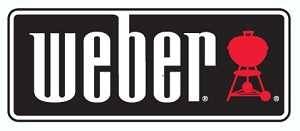
Weber-Stephen is one of the oldest and most respected manufacturers of BBQ equipment and related accessories in the world. Weber grills and smokers cook beautifully and have great features that are clever, effective and easy to use. As popularity and demand for BBQ gear grows worldwide, Weber continues to earn their long standing reputation for quality, durability and outstanding customer service and support, (7 days a week from 7am to 8pm CST), in an increasingly competitive environment. Even in this crowded marketplace, many consumers are still willing to pay more for the Weber name and they are rarely disappointed. They make a variety of cookers and smokers. Their iconic black charcoal kettles are known throughout the world. Indeed Weber is expanding globally.
Weber-Stephen was family owned since it was founded in 1952 by George Stephen. At the end of 2010 the Stephen family sold a majority stake to Chicago investment group BDT Capital Partners. In 2012, Weber settled a class action suit out of court regarding their use of the phrase, “Made in USA”. Weber previously qualified the “Made in USA” statement by specifying their products are assembled in the USA with some components that are sourced globally. Here is an excerpt from Weber’s statement “Weber believes that because all Weber grills and the disputed accessories are designed and engineered in the USA, and all grills save for one line [Spirit]* are manufactured and assembled in the USA using component parts primarily made in the USA, it did nothing wrong and therefore has valid defenses to plaintiff’s claims. The court has not held a trial or ruled in favor of either party on any disputed issues. Weber and the plaintiff have agreed to settle the matter to avoid the costs of continued litigation.” As a result of this suit, Weber can no longer claim to be made in America.
Since then Weber, like many others, has outsourced manufacturing of more product lines. Things change, but we believe Weber’s commitment to quality and innovation has not.
The biggest barrier for many folks is price. Webers are not cheap, but when you consider that they last decades, the price is easy to justify. Many some cheap grills fall apart after three years or so.
Our main complaint: All Webers have the obligatory bi-metal dial thermometer in the hood that gives you a ballpark reading of what the temperature is high above the meat. Since we cook on the grates, though, it’s always better to bring your own digital thermometer and place a probe there. It appears this is beginning to change as Weber enters a new era of digital technology and software based products.
Related reviews
-
Max Good, AmazingRibs.com’s Full-Time Grill Tester - Max Good is AmazingRibs.com's Vice President of Product Reviews & Keeper of the Flame and is the world's only full-time reviewer of outdoor cooking equipment including smokers, grills, pizza ovens, griddles, and more.
Up Your BBQ IQ By Joining The Pitmaster Club

Sign up for a free trial of the AmazingRibs.com Pitmaster Club and experience everything that the world’s largest membership-based BBQ and grilling community has to offer!

High quality websites are expensive to run. If you help us, we’ll pay you back bigtime with an ad-free experience and a lot of freebies!
Millions come to AmazingRibs.com every month for high quality tested recipes, tips on technique, science, mythbusting, product reviews, and inspiration. But it is expensive to run a website with more than 2,000 pages and we don’t have a big corporate partner to subsidize us.
Our most important source of sustenance is people who join our Pitmaster Club. But please don’t think of it as a donation. Members get MANY great benefits. We block all third-party ads, we give members free ebooks, magazines, interviews, webinars, more recipes, a monthly sweepstakes with prizes worth up to $2,000, discounts on products, and best of all a community of like-minded cooks free of flame wars. Click below to see all the benefits, take a free 30 day trial, and help keep this site alive.
Post comments and questions below
1) Please try the search box at the top of every page before you ask for help.
2) Try to post your question to the appropriate page.
3) Tell us everything we need to know to help such as the type of cooker and thermometer. Dial thermometers are often off by as much as 50°F so if you are not using a good digital thermometer we probably can’t help you with time and temp questions. Please read this article about thermometers.
4) If you are a member of the Pitmaster Club, your comments login is probably different.
5) Posts with links in them may not appear immediately.
Moderators